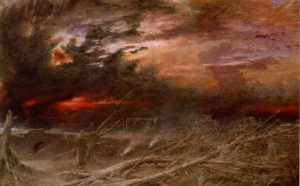
I’m going to write a story where the world is on the brink of destruction. Few people, if any, will survive.
Simple enough. And dark enough to fit this month’s theme of dark and pulpy fiction.
Or maybe not.
Even though the high-level setting is pretty dark, I get to choose where I drop the story on the Darkness Spectrum. That choice helps set the tone, which will impact everything from plot to character to conflict.
For example, I could take a popular route and make it a gritty, YA post-apocalyptic story, like Divergent, by Veronica Roth, or Suzanne Collins’ The Hunter Games.
Or I could engage afterburners and drive it all the way to the extreme end of the spectrum and make it Horror, like The Stand, by Stephen King.
I could dial back the gore a bit and choose a Dark Fantasy, like The Warded Man by Peter V Brett, or really Dark Fantasy like Joe Abercrombe’s The Way of Shadows.
Or I could make it Epic Fantasy with some cool horrific elements, like The Elfstones of Shannara by Terry Brooks.
Then again, I could go the other way entirely and make it a light-hearted humorous tale, like Douglas Adams’ hilarious Hitchhiker’s Guide to the Galaxy.
This fundamental choice of tone sets the stage for much of the book’s progression. This month we’re talking about pulpy, dark fiction. Those stories must generate the proper emotions, ranging from fear, to abject terror, to loathing, to revulsion.
Although all of my stories have dark elements, I generally soften those edges with a lighter tone. That was a conscious choice I made, based on which aspects of the adventure I wanted to focus on, and my target audience.
Set in Stone, and its sequels in my Petralist series are YA epic fantasy, with big magic, big adventure, and lots of humor. The humor makes the tales accessible to all ages and helps the readers laugh through what could have easily become very dark, desperate scenes.
In my Facetakers sci-fi/fantasy time travel thrillers, some elements, like the extraction of human souls by pulling of people’s faces, can be borderline horrific. There’s a lot of fast-paced action and some really high-stakes challenges. The tone of the book is more gritty and dark than the Petralist, fitting for New Adult thrillers.
So choose your tone as a conscious decision, as part of your story development, along with character, voice, setting, conflict, and plot, and it will help set the foundation those other elements build upon.
(This post is features on the Fictorians. Check it out there also, along with other great posts this month focusing on dark and pulpy fiction.)